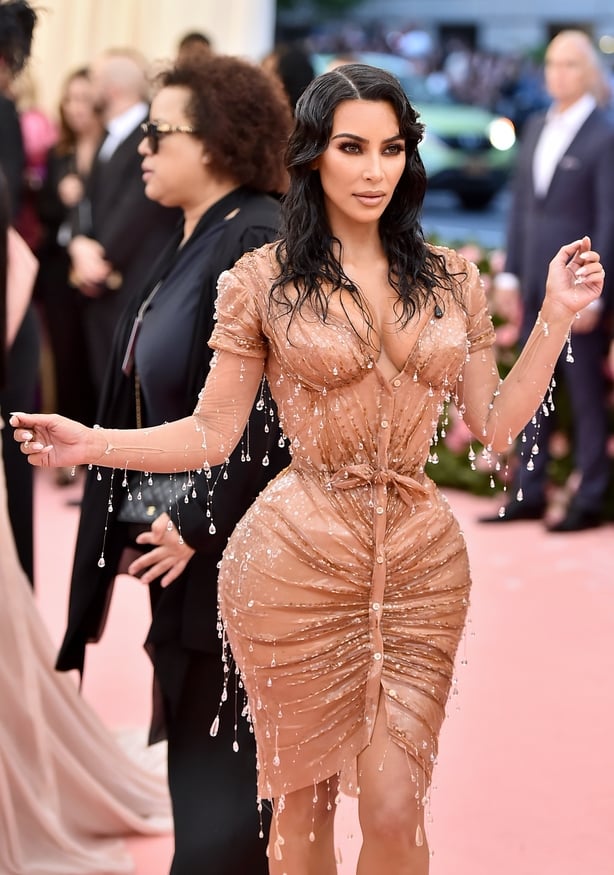Back in 2014, US Vogue, under Anna Wintour's reign, published an article proclaiming it was "officially the era of the big booty". A glistening take, but an altogether unsurprising one for a magazine infamous for hiring in categories both slim and white.
It kicked off, or perhaps alluded to, one of the oddest legacies of the then rapidly expiring decade: the gradual emergence, among professionally beautiful women, of a single, automated, uniform look.
It was, of course, the year of Kim Kardashian's body 'breaking the internet', her Paper magazine covershoot showcasing her bare curves, slicked with oil, all the while providing a steady enough set-down for a large glass of champagne.
Kardashian, and indeed her family, have historically been largely credited with trends pivoting at breakneck speed, and although Kim has unequivocally denied having surgery and thus never self-promoted to followers, her cover– unveiling both herself as a forthcoming fashion tour-de-force, and an unusually large rear for a white woman –many believe, was the catalyst for Brazillian Butt Lifts (BBLs) in particular and aesthetic procedures in general, the former growing worldwide by 77.6% in the years that followed.
But Kim has recently showcased a new, streamlined, slimmer body type–a back-and-forth process entirely gatekept by wealthy, largely-white women.
So, what does this mean for the average woman among her 320M Instagram followers? And what about the women who got one–what do they do now?

Historically, for women, and incrementally now men, à la carte body types trending are not new.
In the 1960s, slim women were told to gain weight in order to lean into Marilyn Manroe's softness and sex appeal, women living within the Italian Renaissance were subjected to similar standards, with men preferring those of ample bosom and pillowy lips, while those who resided under the Han Dynasty, were shackled by the urgency of slim waists, pale skin and tiny, bounded feet.
For those growing up in the early 1990s, the words 'heroin chic' will forever strike a chord synonymous with cigarette smoke and disordered eating, categorising the human body into an unusual public-facing subject that needed to be downsized and harshly twisted.
For Generation Z, and anyone else young enough to have missed such infamy, BBLs neatly fill that void.

Originating in Brazil, the global centre of aesthetic surgery (Brazillian patients are thought of as having the "right to beauty", which means that, in public hospitals, plastic surgeries are free or low-cost, and the government subsidises nearly half a million surgeries every year) BBLs rose in popularity in the 1990s, when New York City plastic surgeon Sydney Coleman published a series of papers outlining standardised practices for the complex procedure.
The surgery itself was pioneered by the Brazilian doctor Ivo Pitanguy, known as "the pope" among the country's plastic surgery elite. He performed a variety of procedures, founded the world's first plastic surgery academy, and eventually obtained enough money to buy himself an island.
The story goes that, according to Pitanguy (who once made the case that ugliness caused so much psychological suffering in Brazil that the medical class could not turn its back on this humanitarian issue) the perfect posterior is taut and orb-like, 45 degrees from the base of the back to the apex of the cheek.
Working in tandem with similarly pert breasts, the body should make the shape of an S when the woman is in profile.

According to a paper by a group of evolutionary psychologists published in the journal Evolution and Human Behaviour in 2015, "lumbar curvature" apparently signified a woman's ability to bear children, and so deemed her attractive as a mate.
As the authors tenderly put it: "Men tended to prefer women exhibiting cues to a degree of vertebral wedging closer to the optimum."
We see this sort of pivoting towards 'optimal vertebral wedging' all the time - padded bras, corsets, flat tummy teas, shapewear – contorting our bodies for a myriad of reasons, as the women before us also deigned to do.
And yet, those who seek to obtain permanence in these realms, which clearly reap dividends among the professionally beautiful, risk paying the ultimate price.
In 2017, Dr Mark Mofid, a leading American BBL surgeon, published a paper in the Aesthetic Surgery Journal which revealed that 3% of the 692 surgeons he had surveyed had experienced the death of a patient after performing the surgery.
Overall, one in 3,000 BBLs resulted in death, making it the world's most dangerous cosmetic procedure.
"You cannot enjoy the rhythm and ignore the blues"
— BBC Radio 1 (@BBCR1) June 2, 2020
This is incredibly powerful from @claraamfo on the death of George Floyd, racism and its effect on her own mental health. pic.twitter.com/qxHrvKfn0e
For a relative outsider looking in, one may earnestly believe that the uptick in BBLs is a direct result of the influence of blackfishing, the act of White people appropriating Black culture by changing their speech, their hair or their skin tone.
The term was coined by journalist Wanna Thompson after she saw a Twitter discussion about white women cosplaying as black women.
"Blackfishing is an issue because it allows a person to pick and choose the "cool" parts of being black, without facing any of the discrimination that black people do," Thompson said. "Black is cool, unless you're actually black," she continued, echoing BBC broadcaster Clara Amfo's poignant statement in the aftermath of George Floyd's passing: "You cannot enjoy the rhythm and ignore the blues".
Aesthetic surgery has always been inseparable from the politics of race. The fetishisation of Black women's bodies hails as far back as 1810, when the first recorded case of subjugated human trafficking centred around Saartjie Baartman, a South African woman who was brought to London by a British doctor and exhibited in Piccadilly, and then around the country, as the "Hottentot Venus".
Crowds would pay to examine her body and her buttocks in particular. (When Kardashian posed for Paper, observers compared the image to pictures of Baartman used to advertise her "performances".)
Saartjie Baartman was a South African woman who was exhibited in English "Freak Shows" as "The Hottentot Venus". She died in 1815, and her remains were on public display right up until 1974. #ScientificRacism #BlackHistory pic.twitter.com/F8JgUV3TGV
— BlackHistoryStudies (@BlkHistStudies) November 29, 2021
Indeed, plastic surgery itself has roots in the racist and classist ideology of eugenics, a belief that the "genetic quality" of the human race can be improved by discouraging or outright ceasing those deemed inferior from reproducing.
Historically, and still in modern times, society prized whiteness as the most desirable asset. BBLs seemed to somehow flip the script, with typically non-white phenotypes like curves being celebrated. However, that celebration was predominantly on the bodies of wealthy white women.
As a result, the BBL has become an asset that generates racialised capital. Yet such is the case when women's bodies become commodified for capitalistic good.

Lips rip from excess filler, ribs protrude from calorie counting and women as young as teenagers risk cardiopulmonary collapse for the perfect buttocks. The house always wins.
It's all but impossible to abstain from beauty marketing in a world obsessed, despite our tightened, frozen and tweaked bodies remaining inherently alive, moving and unpredictable.
Perhaps its storied decline is a direct result of White people's growing knowledge and understanding of Black culture, a hesitancy to appropriate and an altogether respectful, albeit White guilt-adjacent respect for Black culture that was never there before.
Or perhaps it's just that the Kardashian-Jenners have been called out one too many times, and we worry the same is waiting for ourselves.
It remains left to be seen whether the sun has set on the era of the BBL, but there is one thing we can be sure of; the close of this era brings with it a shiny new one, one that has followed a trail of breadcrumbs leading it to commodify female bodies towards the next sumptuous bite.
If you have been affected by issues raised in this story, please visit: www.rte.ie/helplines.
The views expressed here are those of the author and do not represent or reflect the views of RTÉ.


